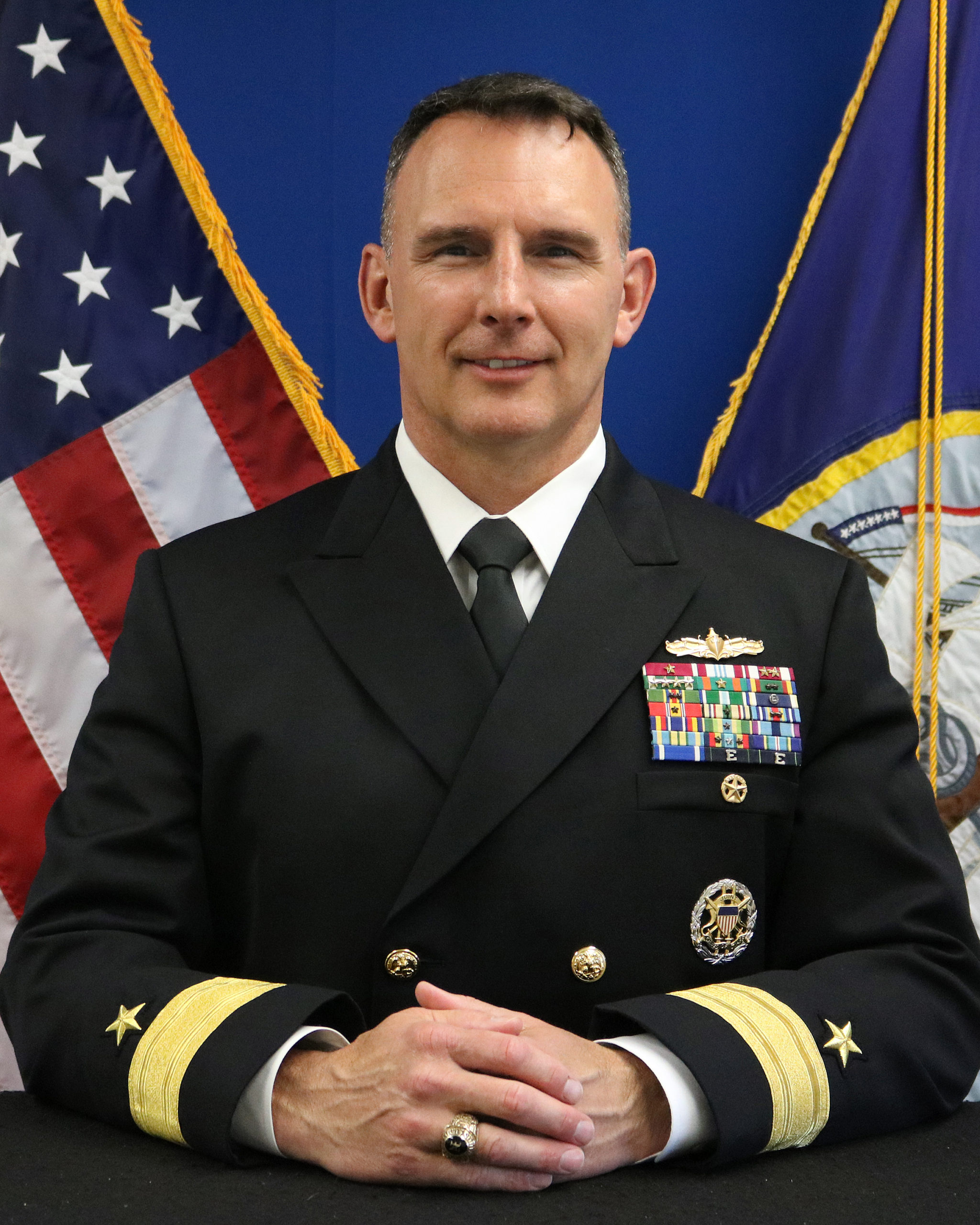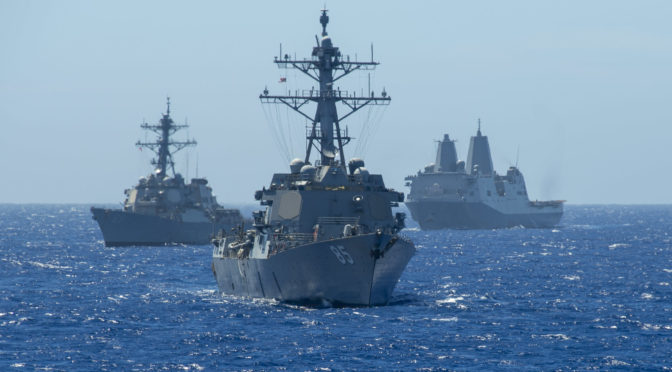By Dmitry Filipoff
CIMSEC had the opportunity to discuss the growth and evolution of the U.S. Surface Navy’s lethality with Rear Admiral Scott Robertson, commander of the Surface and Mine Warfighting Development Center (SMWDC). In this discussion RDML Robertson discusses the cutting edge of Surface Navy training and tactical development, and how SMWDC is planning to take its efforts to the next level.
Much of SMWDC’s effort is geared toward being a learning organization, whether through experimenting with tactics, training WTIs, and digesting technical data gathered from exercises. Going across your various lines of effort, what exactly is being learned and taught by SMWDC?
The center of gravity for SMWDC is our Warfare Tactics Instructors (WTI) produced through our WTI courses of instruction. We have four different specialty strands to meet Fleet needs and each one has differing lengths. All WTI strands focus on warfare theory, deep understanding of surface warfare Tactics, Techniques, and Procedures (TTP), study of adversary capabilities and limitations, standardized instructional techniques, and then repetitive application of knowledge in complex scenarios.
SMWDC’s premier contribution to tactical training is Surface Warfare Advanced Tactical Training (SWATT) exercises held for ships in the advanced phase contained within the OFRP cycle. A SWATT has both in-port academics instruction and underway training exercises to teach TTPs through scenarios of increasing complexity. During a SWATT, the SMWDC team collects performance data related to metrics, developed and associated with surface warfare TTPs. This data collection allows us to do a number of things. First, it gives quantitative feedback to the ship crews so they can learn from the at-sea exercises and execute TTPs with increased speed and accuracy. Secondly, it gives SMWDC a better measure of the fleet’s overall increase in lethality and unveils areas that need focus or improvement. Lastly, SWATT can isolate and assess gaps in individual, watchteam, and unit-level training that exist and need to be filled to maximize our ship’s warfighting potential.
SWATT, among other underway exercises, allows us to further TTPs in two additional ways. First, it gives us the opportunity to validate, or affirm, that our TTPs work and identify what adjustments need to be made based on our application in a controlled environment. Secondly, it provides the opportunity to work TTP development and experimentation to ensure we can deliver the right TTPs, at the right time, as new systems and capability are delivered to the Fleet, as well as changes to employment methodologies required to keep adversaries at risk.

We’ve leveraged real-world events to dissect the situation and examine TTPs executed, including weapons system performance and watchstander actions to identify where expectations did or did not meet reality in response to operational commanders’ requests. This has allowed us to tailor our TTP development and training of our WTI cadre in the pertinent WTI COI.
With the release of the National Defense Strategy, great power competition has become the primary focus of the Department of Defense after years of focusing on rogue states and counterinsurgency. What does a return to great power competition mean for SMWDC, and how do you operationalize this guidance and tailor your efforts?
The nature of SMWDC’s establishment and identified lines of operation in our codified Missions, Functions, and Tasks (MF&T) is a measure the Navy as a whole has taken to “operationalize” and act upon the higher-level national security guidance. Therefore, the answer is simple: carry out our assigned duties in our MF&T and continue to learn and build upon our execution as described earlier.
The return to great power competition also means that we have to conduct all of our training (both for WTIs and SWATT) at a level that closely represents or even exceeds the anticipated environment (volume and multi-domain warfare-wise) our ships will need to operate in should a conflict with a great power adversary occur.
A major function of SMWDC is integrating tactical development across the surface warfare enterprise, and ensuring cross-cutting conversations are happening between various entities. How is this integration an improvement from the past, and especially with communicating across communities to their own Warfighting Development Centers?
Before the development of SMWDC (and the greater WDC concept) we had Warfare Centers of Excellence that were separated into entities based on warfare areas (i.e. surface, subsurface, missile defense) rather than tied to an entire naval community (i.e. aviation, surface, subsurface, information warfare, expeditionary warfare). From a Surface Navy perspective, the stovepiping of efforts hindered alignment and cross-warfare area TTP development. Furthermore, the previous WCOEs were charged with conducting work on the intellectual side (TTP development and validation) but not so much on the training and operational side (i.e. the equivalent of a SWATT exercise). Now that all surface warfare areas are combined under one command, we can easily govern cross-warfare area TTP development while providing advanced tactical training to the fleet. The current WDC construct truly enables better alignment and supports increased integration across communities; there are more and more connection points between the WDCs and Naval Warfare Development Command.
How has SMWDC and the WTI program influenced the career continuum for SWOs?
There are three ideal entry points into the WTI training pipeline (not in order of preference), namely between one’s first and second division officer tour (advanced warfighter program), after one’s division officer tours during their shore duty, or after one’s department head tours during shore duty.
All of these entry points are congruent with the current SWO career continuum model such that they do not interfere with the sea/shore tour lengths or milestone goals such as starting Department Head School by the 7.5 year mark. The program is still in the development stages. However, we’re beginning to see our first waves of command-eligible SWO WTIs go before selection boards and have initially high screening rates for patch wearers. Bottom line, the surface warfare community values our WTIs and it shows in milestone selection figures.
One of the founding visions has been the idea of having a Fleet full of patch wearers manning our ships at the Commanding Officer, Executive Officer, and Department Head levels. The overall increase in the tactical proficiency and thus lethality of our ships will be impressive and measurable. We are well on our way.
What is the envisioned working relationship between SMWDC and the newly formed Surface Development Squadron?
SMWDC will work with SURFDEVRON to leverage opportunities to develop TTPs and conduct experimentation in conjunction with the DDG-1000-class to shape our understanding on how we can optimize the capabilities this platform brings to the fight. SURFDEVRON is also SMWDC’s gateway to developing the needed TTPs to integrate with coming unmanned assets.
The SMWDC-led series of Surface Warfare Advanced Tactical Training (SWATT) exercises are pushing the surface fleet further out from its comfort zone. How are you looking to enhance and expand these exercises?
As we develop capabilities to combat emerging threats, we will expand SWATT schedules of events to ensure we’re flexing said developed capabilities to give our operators a chance to see the capabilities in action and build a level of comfort employing their weapon systems. In the near term, we will be elevating our exercise complexity and be working to induce more failure to stretch ship crews. We envision incorporating unmanned systems and presenting training targets across different domains that mimic profiles that replicate the most stressing threats. SMWDC is also looking to add more offensive-based exercises vice the traditional heavier bias toward the defensive. Lastly, we also know that Live, Virtual, Constructive (VLC) training is a must for inclusion in our future SWATTs to truly train at the high-end.
Rear Adm. Robertson assumed the duties as commander, Naval Surface and Mine Warfighting Development Command, in May 2019. Robertson has served in a highly diverse range of assignments and participated in many campaigns and operations. His sea tours include: 1st division officer onboard USS George Washington (CVN 73); fire control officer onboard USS Normandy (CG 60); weapons/combat systems officer onboard USS Port Royal (CG 73); engineering auxiliaries officer on USS John C. Stennis (CVN 74); and executive officer on USS Gettysburg (CG 64). Robertson commanded USS Rodney M. Davis (FFG 60) during a seven-month counter-narcotics deployment; he also commanded and deployed with USS Normandy (CG 60), the first Aegis Baseline 9 warship with Naval Integrated Fire Control – Counter Air capability. Additionally, he served as Air and Missile defense commander for the USS Theodore Roosevelt Carrier Strike Group. Robertson’s shore assignments include Aegis Training and Readiness Center (ATRC) as course supervisor and lead instructor for the Force Air Defense Warfare Commanders Course; Joint Staff, J-8 Directorate as the resources and acquisition manager; and commanding officer of Surface Warfare Officers Schools (SWOS) Command.
Dmitry Filipoff is CIMSEC’s Director of Online Content. Contact him at [email protected].
Featured Image: PHILIPPINE SEA (March 14, 2019) The Arleigh Burke-class guided-missile destroyer USS McCampbell (DDG 85), the Arleigh Burke-class guided-missile destroyer USS Milius (DDG 69), and the amphibious transport dock ship USS Green Bay (LPD 20) maneuver while operating in the Philippine Sea. U.S. Navy warships train together to increase the tactical proficiency, lethality, and interoperability of participating units in an Era of Great Power Competition. (U.S. Navy photo by Mass Communication Specialist 2nd Class John Harris/Released)


A concern that I have with the WDC approach is that it focuses on a single community (i.e. SWOs) whereas the WCOE approach brought together multiple communities to deal with a given threat (i.e. ASW).
It’s all well and good for the SWO community to have lots of “patch-wearing” WTIs, but naval war is a combined arms operation. Air, surface, undersea. Where is cross-community TTP development occurring?
Matthew, your concern is quite valid. However, rest assured there is tremendous collaboration between all of the WDCs, including NIWDC. We work together on not only writing TTP but also in validating it through experimentation, exercises, or simulation. We all know we must be an integrated force, not just interoperable. WDCs are very much working together.